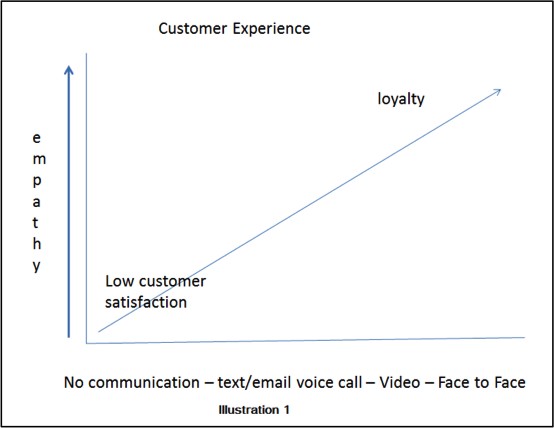Let’s be honest, we’ve all had our fair share of bad customer service experiences. In today’s highly complex and automated world, it’s all too easy to end up feeling like the companies we do business with just don’t care. To look at this from the other side, the consequences of customer dissatisfaction can be profound and can have a significant knock-on effect for the ongoing marketing and sales efforts. This is especially true when you consider a recent RightNow Customer Experience Impact Report found a whopping 89 per cent of consumers said they would stop doing business with a company after experiencing poor customer service. It goes without saying that no organisation can afford to lose customers at such a high rate. Yet this poses businesses with a challenge in terms of keeping their customer base happy.
It may not be realistic for customer service organisations to solve every problem in a single interaction. It is possible, however, to engage and connect with customers each and every time. This can be achieved by putting empathy at the forefront of customer engagement, which means seeing through the customer’s lens and understanding their experiences and emotions firsthand. Empathy, therefore, is crucial to great customer service. And showing empathy as quickly as possible can go a long way towards converting a one-off customer purchase into a long-term relationship.
Written communication can be misinterpreted
In our omnichannel and connected business world, customer service organisations have a wide range of social and CRM tools at their disposal. Yet these tools, in and of themselves, don’t necessarily equate to exceptional service that drives repeat business and loyalty. While omnichannel platforms and automated communication techniques certainly have a place in today’s busy environment, they lack the most important ingredient – an ability to show empathy that comes from human interaction.
The problem with these tools often boils down to tone. Unfortunately, the written word isn’t always effective at conveying nuances associated with empathy. It’s too easy to unintentionally come across as cold and direct in an email or text. When using these communications methods, therefore, it’s essential for businesses to make a point to start with a friendly greeting or introduction before getting into the details of addressing the customer incident. This helps to keep intent from being misinterpreted.
Always be connecting
When customer service professionals are empathetic, they connect much better with their customers. The level of connection and the amount of empathy displayed will often determine the quality of the customer experience. It goes without saying that solving the customer’s problem is the primary goal of any interaction, but how well these professionals connect with the customer will strongly influence how they feel about the company.
Customer satisfaction can often be tied to how they connect with the customer service representative and then how well that representative is able to demonstrate empathy. This is where using the latest technology can help, best demonstrated by the illustration (right).
It’s called the empathy curve. Whenever a customer is unable to connect with customer service there is no empathy and customer satisfaction is negative, or poor at best. It’s at this point tweets start flying. As we move up the curve, a text message, chat, email, or social media response offers a minimum level of connection and an equally minimal opportunity for empathy. While it’s better than no response at all, the level of customer satisfaction is probably going to be fairly low.
The highest level of connection on the empathy curve is a face-to-face exchange. While it may not always be possible to meet in person, two-way video conferencing does make it possible to deal with customers face-to-face without having to be there. Empathy is at its highest when two people can ready each other’s expressions and shares that emotional connection. This can even work when only the customer service representatives’ face can be seen.
I’ll give you an example that recently happened to me. I was working with an important customer, but they didn’t have video conferencing capabilities on their end. So I set up a half-duplex video call where they could see me but I could only hear them. I positioned my notes in a way where I was able to look directly at the camera at all times, showing I was paying attention to them and allowing me to engage and show my empathy. Not only did we solve their problem, but they knew they had a partner who really cared that they were satisfied.
Connecting by phone is the next best thing to being there. According to a recent eConsultancy survey, 61 per cent of consumers prefer assistance over the phone. A voice-to-voice call provides a tremendous opportunity for customer service professionals to connect with a customer and be truly empathic. By listening to the customer’s issue and understanding their frustration, a service representative can show that the company cares.
At Netscout, this approach to customer service is at the heart of what we do – a representative picks up 96 per cent of calls to the company – and have seen first hand the benefits it delivers. An approach like this has been proven to have a lasting, positive effect on customer engagement and loyalty. The first person a customer talks to may not be able to solve the problem, granted, but the issue can be triaged up front by making a warm transfer to someone who can.
Training to be more empathetic
It’s safe to say that being empathic comes more naturally to some than others. But fortunately empathy can be learned, which is especially good news for customer service organisations. In the end, being empathetic is all about seeing things through the customer’s eyes. By putting yourself in the customer’s shoes, it’s possible to better understand the emotions behind their experience. This is the very definition of empathy.
Basic customer service training that focuses on the “always be connecting” principle can go a long way towards becoming more empathic with customers. Paying attention to a customer’s tone and allowing them to express their emotions, whether stress or frustration, is key to an empathic response. A combination of using the highest level of communication that allows the greatest empathy, staying focused, and closing out issues in a timely manner, will drive a deeper and more satisfying customer experience. And that can only be good for business.





